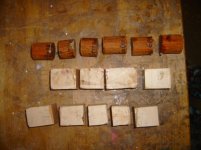If you have any similar tests please post.
I have wanted to do this for a long time and the results surprised me. It's hard to say if these results are accurate but they did show me what further tests are needed. I was surprised how brittle slow epoxy was.
I changed where I put the glue on each piece to get better results. The first Maple test was accomplished by throwing the test piece at the ground. The second test were mounted in a vice and impacted with a hammer.
Test 1:
Maple end grain and thrown to the ground.
1. Superglue glue broke with medium impact.
2. 15 minute epoxy broke second with medium impact.
3. 5 minute epoxy broke third and took several hard impacts to accomplish.
Test 2:
Maple end grain hammer test.
1. Gorilla glue failed with a light blow.
2. 30 minute epoxy failed with light blow.
3. 5 minute epoxy failed with meduim blow.
4. Titebond III failed with hard blow.
Titebond III was the winner of this test.
Test 3:
Cocobolo end grain hammer test. After the first 2 tests I felt the hammer test was more accurate.
1. 30 minute Epoxy failed easily with light blow.
2. 5 minute Epoxy failed with a medium blow.
3. Titebond original (red label) failed with medium blow.
4. Superglue failed with several medium blows.
5. Titebond III (Green label) failed with several hard blows.
Results are listed in order of worst to first. (1=worst)
This is a good start for future testing. My next test will be with Phenolic.
Titebond III was the strongest with the tests I did.
I have wanted to do this for a long time and the results surprised me. It's hard to say if these results are accurate but they did show me what further tests are needed. I was surprised how brittle slow epoxy was.
I changed where I put the glue on each piece to get better results. The first Maple test was accomplished by throwing the test piece at the ground. The second test were mounted in a vice and impacted with a hammer.
Test 1:
Maple end grain and thrown to the ground.
1. Superglue glue broke with medium impact.
2. 15 minute epoxy broke second with medium impact.
3. 5 minute epoxy broke third and took several hard impacts to accomplish.
Test 2:
Maple end grain hammer test.
1. Gorilla glue failed with a light blow.
2. 30 minute epoxy failed with light blow.
3. 5 minute epoxy failed with meduim blow.
4. Titebond III failed with hard blow.
Titebond III was the winner of this test.
Test 3:
Cocobolo end grain hammer test. After the first 2 tests I felt the hammer test was more accurate.
1. 30 minute Epoxy failed easily with light blow.
2. 5 minute Epoxy failed with a medium blow.
3. Titebond original (red label) failed with medium blow.
4. Superglue failed with several medium blows.
5. Titebond III (Green label) failed with several hard blows.
Results are listed in order of worst to first. (1=worst)
This is a good start for future testing. My next test will be with Phenolic.
Titebond III was the strongest with the tests I did.
Attachments
Last edited:

